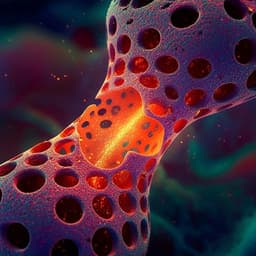Introduction
Magnetic skyrmions, possessing well-defined spin textures and topologically non-trivial properties, hold immense potential for various spintronic applications including information storage, processing, and neuromorphic computing. However, their practical implementation faces challenges, primarily the inefficient generation and control of skyrmions, particularly the suppression of the SkHE. While progress has been made in reducing SkHE in materials like ferrimagnets and synthetic antiferromagnets, achieving organized skyrmion creation and current-driven motion with negligible SkHE in ferromagnets remains a significant hurdle. This research aims to address this challenge by leveraging the precise control offered by surface acoustic waves (SAWs). SAWs are mechanical waves that propagate on the surface of piezoelectric materials, generating alternating strain that can modify magnetic interactions via the magnetoelastic effect. This offers a promising avenue for manipulating magnetic textures at the nanoscale with high controllability. Previous studies have utilized SAWs to induce magnetization oscillations, assist magnetic moment switching, and control magnetic texture dynamics. This study investigates the potential of SAWs to achieve ordered skyrmion generation and current-driven motion with suppressed SkHE in ferromagnetic systems, thereby paving the way for more efficient and reliable skyrmion-based devices.
Literature Review
Magnetic skyrmions were initially observed in chiral itinerant-electron magnets like MnSi at low temperatures. Subsequent research explored various methods for generating skyrmions at room temperature in magnetic multilayers with interfacial Dzyaloshinskii-Moriya interaction (DMI), including magnetic fields, electric currents/fields, and thermal gradients. However, these methods typically resulted in randomly distributed skyrmions, hindering their use as information carriers. The SkHE, caused by the Magnus force acting on skyrmions due to their topological charge, further complicates skyrmion motion in devices, deflecting their trajectories from the driving current. Although ferrimagnets and synthetic antiferromagnets have shown promise in reducing SkHE, the organized creation and current-driven movement of skyrmions with negligible SkHE in prototypical ferromagnets remain elusive, limiting their practical applications.
Methodology
The researchers fabricated an integrated SAW device by embedding a [Co/Pd] multilayer into a SAW delay line. Comb-shaped interdigital transducers (IDTs) were used to generate both thermal effects and SAWs. The Co/Pd/Co/Pd/Co/Pt multilayer structure was chosen for its suitable magnetic parameters and reduced dipolar fields, favoring skyrmion stability. The delay line device consists of two-port IDTs with a magnetic channel embedded in the cavity. A radio-frequency (RF) voltage was applied to the IDTs to excite the SAWs and generate a thermal effect. The longitudinal leaky SAW (LLSAW) at 365.65 MHz provided both the strain and thermal effect. Magneto-optical Kerr effect (MOKE) microscopy was used to observe the magnetic domain patterns and skyrmion behavior. The temperature distribution was monitored using an infrared camera. Current pulses were applied to induce skyrmion movement, and the movement trajectories were analyzed to assess the SkHE. Micromagnetic simulations were performed to complement the experimental findings and provide insights into the underlying mechanisms. The simulations considered the magnetoelastic coupling energy, which depends on the strain tensor induced by the SAWs, and the influence of this coupling on skyrmion stability and alignment. The device fabrication involved UV lithography, electron beam evaporation of Ti/Al for the IDTs, and optical lithography and lift-off processes to pattern the magnetic channel. RF and MOKE measurements were employed to characterize the device performance and observe skyrmion dynamics.
Key Findings
The experimental results demonstrate the ordered generation of skyrmions under SAW excitation. The skyrmions initially formed a random distribution, but subsequently aligned at the antinodes of the SAWs, exhibiting an ordered arrangement. This ordered alignment was observed using MOKE microscopy. The current-induced skyrmion movement showed negligible SkHE, with skyrmions moving largely along the direction of the current pulses. This contrasts with control experiments using a heater to induce skyrmion generation, where the skyrmions were randomly distributed and exhibited significant SkHE. Quantitative analysis of the skyrmion Hall angle (θsk) showed a significant reduction in SkHE in the presence of SAWs compared to the thermal-effect-only case. Micromagnetic simulations confirmed these findings, showing that the SAW-induced strain gradient redistributes the system's energy, making skyrmions more stable at the antinodes of the SAW, leading to their ordered alignment. The simulations also demonstrated the nearly straight-line current-induced motion of skyrmions under SAW excitation, further supporting the experimental observation of reduced SkHE.
Discussion
The successful ordered generation and controlled movement of skyrmions with negligible SkHE in a ferromagnetic system addresses a long-standing challenge in skyrmionics. The use of SAWs provides a novel and efficient method for manipulating skyrmions, offering a significant advantage over previous methods. The findings demonstrate that the combination of SAW-induced strain and thermal effects plays a crucial role in both the ordered creation and the suppression of SkHE. The observed energy redistribution caused by the strain gradient offers a powerful mechanism for controlling skyrmion dynamics. These results have substantial implications for the development of skyrmion-based devices, potentially enabling more reliable and efficient spintronic applications. The observed reduction in SkHE is particularly important, as it is a major obstacle in utilizing skyrmions for technological applications.
Conclusion
This research successfully demonstrated the ordered generation and controlled movement of skyrmions in a ferromagnetic system using an integrated SAW device. The combination of SAW-induced strain and thermal effects resulted in the alignment of skyrmions at the antinodes of the SAWs and a significant reduction in the SkHE. This approach presents a novel and effective method for manipulating skyrmions, paving the way for advancements in skyrmion-based spintronic devices. Future research could explore different magnetic materials and SAW frequencies to optimize skyrmion control and explore the potential of this method in various spintronic applications.
Limitations
The study focused on a specific [Co/Pd] multilayer structure and SAW frequency. The generalizability of the findings to other material systems and frequencies requires further investigation. The simulations were performed in a quasi-two-dimensional system, and three-dimensional simulations may be necessary for a more comprehensive understanding of the underlying mechanisms. The observed pinning effects could potentially limit the speed and scalability of skyrmion-based devices in some scenarios. Further research is needed to mitigate these effects and potentially leverage them in certain applications.
Related Publications
Explore these studies to deepen your understanding of the subject.






